By Eric Davis
“The way is in training.”
Miyamoto Musashi
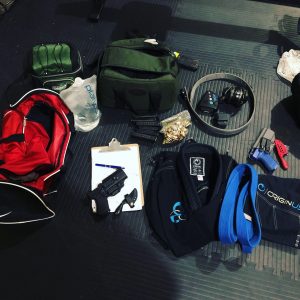
Day of training and the tools needed
This piece is based on a couple of our previous podcasts, Evolution Security Training essentials 1 and 2.
If you are new to self-defense, it can be very tough to decide where to place your training focus. Partly because there is a lot of noise out there from self-proclaimed experts, and frankly, the information available can be daunting. Lastly, even those that are solid veterans may want to sure up some new skills as well. When I was new to being armed, I was like most young men, I was a Dunning Krugger poster child and did not know what I didn’t know. Fortunately, along the way, I have met some very impactful mentors who helped me either through direct training or pushing me to get training from other invaluable sources.
Enumerating in order of importance, we will go into some minor detail into each priority. We will follow up with additional blog posts getting into greater detail for the individual skills. Some will ask, why is medical not listed? We believe that medical is a priority, i.e., listen to the Essentials 2 episode. For brevity in this piece, we are only discussing what will get you through the fight first.
- Avoidance, Verbalization and de-escalation skills
- Physical Fitness
- Mindset
- Jiu-Jitsu and/or Wrestling
- Firearms
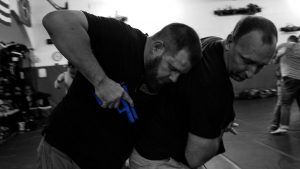
ECQC Olympia 2019
I. Avoidance, Verbalization, and De-escalation skills. Bar none, far and away, the essential skill is avoiding the fight entirely. There are multiple takes on this crucial skill, but we adhere to and espouse Managing Unknown Contacts (MUC) as taught by Craig Douglas of Shivworks. Pre-Assault indicators, managing space with unknown individuals, proper movement, and being academic of human behavior are all subcategories of this skill. We will not go into great detail into methods as this is a nuanced practice, and practitioners should seek training under a watchful eye. You can find Shivworks classes around the US. Some other Shivworks collective instructors teaching MUK are Cecil Burch of Immediate Action Combatives, Paul Sharp of Sharp Defense, Chris Fry, William Aprill of Aprill Risk Consulting, and more. EvoSec provides instruction in MUC as well. Space is crucial to have the reaction time needed to defend oneself in case of an ambush effectively. A single foot length can be life or death space. Knowing how criminals act and or display body tics or subconscious movement and body language can save your life. As a necessary progression in the right direction, simply put away your phone in public, if at all possible, keep your head up and make a habit of paying attention to what is happening around you. The majority of people assaulted are assaulted in transitional space to use Tom Givens of Rangemasters terminology. Transitional space is parking lots or the space between your home and your vehicle, and others similar. You can only concentrate on one thing at a time physiologically, so focus on your surroundings. If people just do this, they will increase their odds of staying safe exponentially. To quote Tom Givens regarding what victims typically say after being assaulted, “They just came out of nowhere.” When the reality is they came from across the parking lot, and the victim just didn’t see them because they were preoccupied. Don’t let people you do not know get within an arm’s length of you, better yet don’t let them get a few paces from you. Simply have your hands up in a “stop” posture or fence as Craig Douglas phrases it, and ask them to “hey, can you back up a bit.” can go a long way in aiding you in keeping yourself and your family more safe. You may have to escalate to a command such as “Hey back up!” This can definitively help you determine if their intention is good or bad, the big difference is that you still have space. To reiterate, seek out formal training on this skill, furthermore, on a reasonably regular bases practice with a training partner or two.
For Craig Douglas classes: www.shivworks.com/
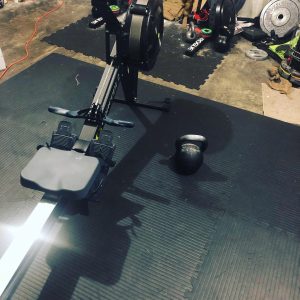
Conditioning is a critical attribute
II. Physical Fitness – The number one killer is not murder; it is heart disease and other health issues that can be avoided or postponed with being fit. I love Larry Lindenman’s saying, “You can’t shoot a heart attack in the face.” The most important physical fitness marker is cardiovascular health and endurance. If you do not have the conditioning to negotiate a fight before it goes lethal, your tool on your belt may not help you, if you can’t even get to it in the first place. The second fitness priority is Strength – Some of the many benefits; assistance in a physical altercation, bone density, and fending off frailty in your later days. Being stronger is proven to extend your life and mitigate life-altering injuries. To use the oft used phrase strength makes you harder to kill.
Some basic beginner levels to above-average baselines are enumerated below. The exercises, suggestions, and measurements are not comprehensive. I do not claim to be a fitness expert. I just provide a few examples to spark discussion. I will also add that you MUST visit your doctor before committing to a new fitness program; I now embrace preventive medicine when I used to avoid it.
Aerobic basics – Start with simply walking 1 mile 3 times a week, this gets you moving, and that is the initial intent. The next goal is a 30 min jog or walks uphill, maintaining 120-140 bpm heart rate; this is actually a very easy pace. Folks can quickly work up to and maintain this as a lifestyle fitness standard without killing themselves. Bonus: maintain an aerobic base of 45-60 min. as a lifestyle a couple of times a week for perpetuity. My cardio sessions are one of my favorite times to catch up on The Evolution Security Podcast.
A good set of average cardio goals: 20 min 2-mile run, 750m row (Concept 2 rower) in 3 min. 300m row in 1 min. 1/4 mile in 2 mins. 8 min 2 Km Row, break 7 min you are doing badass. Notice there is a mix of Aerobic and Anaerobic skills as an example; we should work both as we progress. If these are currently unattainable, that is ok.
Basic strength:
Unless folks have a medical condition, all should be able to do 10 pushups, 1 pullup, 20 bodyweight squats, 20 crunches. This is just a baseline for anyone starting or who has been out of shape for a while and can be goal number 1.
Above-average; 5 dips, 5 pullups, Squat your bodyweight x 10, Example: Bodyweight=190 lbs – 190lb barbell x 10 reps. Deadlift bodyweight x10.
Advanced: 2 x bodyweight Squats x 1 to 2 reps, same on Deadlift. Bodyweight clean and press for 1 to 2 reps.
III. Basic empty hands or Combatives: Again, take note that we have not gotten to weapons yet. You are way more likely to be in a non-lethal fight than one that includes a blaster. Having a requisite level of combatives can also prevent a situation from going lethal for multiple reasons. Secondly, as mentioned above, if you do not have wrestling or grappling skills, you may not be able to get to your weapon if needed. This is a skill we call In Fight Weapons Access (IFWA), credit Craig Douglas. God forbid you are in a fight for your life, but you do not have the skills to deploy a weapon while in the fight.
a. Jiu-Jitsu: We feel Jiu-Jitsu is the best place for everyone to start. It can serve as everyone’s combatives baseline and can be trained in if modified for the rest of your life. Anywhere in the US, you can likely find a decent or, for that matter, a world-class Jiu-Jitsu gym; we highly recommend you research your local area for gyms and at least go check them out. If you are on the fence, most gyms offer a free trial period. Go check it out, give it a try, you just may find a new love.
b. Wrestling – Clinch/Greco-Roman wrestling should be a second priority, especially related to a weapons based environment. You can likely find a local wrestling club to get some lessons. Just be mindful that the level of safety may vary; this is especially a consideration for us in the 40+ demographic. I will add that all of the Shivworks Collective and devotees provide an excellent foundation in Greco clinch.
IV. Mindset – discussed as an essential attribute to a lot of people in the self-protection industry, but how is it developed? It’s simple, you do tough things, you face tough challenges, and you participate in tough training. Great tools for the development of Mindset….Jiu-Jitsu and Physical fitness and the pursuit of fitness. It is lifting heavy weights, participating in Shivworks (notice a theme) ECQC, or any other course that offers a simulation of real fights. Any stress inoculation with simunitions or marking cartridges is a great mindset development tool, and it can significantly aid in your decision-making capabilities.
For more on ECQC and Craig Douglas go to www.shivworks.com/

Tools for force on force/simunitions/simulation safety
V. Firearms – We need to have a quality pistol, be proficient with that pistol, and carry it. Now the law related to carrying your firearm as well. Pick up this book The Law of Self Defense by Andrew Branca. Your pistol is not a talisman that wards off evil. It will not solve all problems, and without the proper mindset in its use, it can cause problems. Per Mas Ayoob, “with great power (pistol), comes great responsibility.” Just owning a pistol is not enough, take a reputable Level 1 pistol class as a start. A trait we see play out time and time again is folks will purchase a pistol, and they will join a range and just blast away at paper targets without any real objective without proper technique and very little progress. We advise all new shooters first to buy a case of ammo and save it so you can attend a class that teaches basic safe firearms handling skills and basic marksmanship. The money and time you save going with this model will be exponential. After you attend that class, you must train the skills learned so that they become subconscious skills.
There are many great firearms instructors, but we highly recommend Tom Givens of Rangemaster. Check out their training schedule and get into a class. https://rangemaster.com/
One other excellent way to get better at shooting is to seek your local IDPA club and start shooting matches. Don’t be concerned with how well you will do; there are shooters of all levels and always experienced competitors that love helping shooters new to IDPA. Add to it the competition is also a minor stress inoculator. For more info on IDPA go to www.idpa.com/
As a bonus, carrying Pepper Spray or Oleoresin Capsicum Spray, is cheap and effective. We believe everyone should carry spray if it is legal for them to do so. One of the best authorities on this subject is Chuck Haggard, of Agile Training. http://agiletactical.com/ Listen to Episode 29 of the Evolution Security Podcast with Chuck, it is an extremely educational show. Also, know the law you live in as it relates to carrying pepper spray before committing to it.
Dry fire – It is the king of practice, and it is free. Dry fire at least 2-3 times a week. If you do not dry fire, you are missing out on likely the number one practice for shooting. One of my new favorite books on dry fire is The Dry Fire Primer by Annette Evans. Pick it up on Amazon on Kindle or Paperback.
Regarding safety, before drawing from the holster live-fire, you must get proper training. Drawing from a holster or, more specifically, re-holstering is where most self-inflicted accidental shootings occur. Get the appropriate training and always observe the four cardinal safety rules (end of post), you will save money and time in the long run and be better for it.
As far as some standards to start to aim for (pun intended), reference below, the drills are easy to set up and achievable over time.
B8 Bull 10 yards slow fire 10 rds, 80 points or better is a start. Achievable – 90 -100 points
The test by Larry Vickers – 10 yards 10 rounds 10 sec on a B8 Bull starting from low ready- Basic: 75 points; Advanced 90-95 or better from a concealed draw.
Basic pistol Presentation:
5 yards – draw and fire one shot from the holster (no concealment) to A zone in 2 sec or better.
More advanced yet attainable:
7 yards from concealment- draw and fire 1 shot to A zone or -0 zone in less than 1.5 seconds. Bill Drill: 7 yards 6 rounds: Draw and fire from concealment in less than 4.5 sec. Accomplished shooters can do this much faster, but this is a good start. 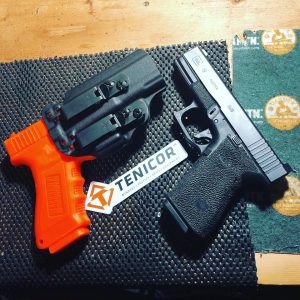
Training Log or journal:
We believe that one of your best training tools is your journal. Yes, you should be recording what you do as it relates to your daily and weekly training. It gives you a way to focus your training and track your progress and set and meet goals. When you discover new classes you want to take, write it down in your future classes page, I love checking those boxes off. We should always test ourselves to an extent using “yardsticks.” in our training path. It doesn’t have to be perfect and doesn’t have to be every day but endeavor to make this a new and consistent habit. Again, I flex the amount of content I put in my journal but rest assured it has been one of my crucial tools for decades. Not to mention, it is helpful to go back in time to either see memories of pivotal events or to see that I have truthfully improved. Of course, the converse of that is I can track if I can no longer meet a standard I once did. I am also mindful to understand that I am getting older; for instance, I will likely never be as strong as I was when I was 27, I am 46 now. That is ok. There are many areas that I am much better than my younger self. I know this because I see it in writing.
If you are new to a training log or journal, for day one, simply start with your goal or goals for the day. If it is to wake early and complete your workout for the day, start with that. Record what you did. A second goal of the day may be to dry fire for 10 min, write that as your second goal. Record what drill you are going to work on, such as the IDPA 5×5 classifier. Record your par times for each string of the drill. Lastly, to finish, what book you are reading and anything new you learned from that book. A second-day entry may be, Jiu-Jitsu Class and what you learned that session. Your day may be a live-fire session at the range, again record your intentions or drills before going and then write down the results. Lastly, you can simply write down something good that happened that day. Full disclosure, I have a separate training log specific for shooting, but my daily journal does include all highlights.
My favorite journal notebook: Moleskine Classic Large
My favorite utility pin: Fischer Space Pen
To summarize, there is more that could be added to this list, but I believe this is an excellent start for anyone wishing to be a more capable protector. For any comments, questions, or discussion points, contact us at crew@evosec.org.
Four Cardinal safety rules:
- Treat All Firearms as if they are loaded, we will add, also know the condition of your firearm.
- Do not cover anything with the muzzle of the weapon you are not willing to destroy
- Keep your finger off the trigger until you are on target and have made the decision to fire. Adding to this rule; the finger is off the trigger, and it is placed in the high register position as high as possible on the firearm. Think about touching the top of the corner of the slide and breach of the pistol. The high register gives us a real good tactile location for “knowing” that our finger is off of the trigger. Again, credit to Craig Douglas of Shivworks.
- Know the targets foreground and what is beyond it.


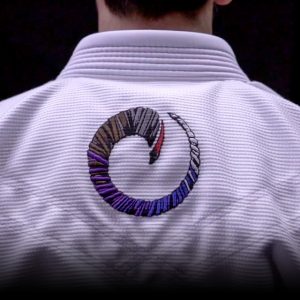
Recent Comments